基于铁磁薄膜可调谐太赫兹微结构的研究
章 强,张晓渝,邢园园,赵 磊
基于铁磁薄膜可调谐太赫兹微结构的研究
章 强,张晓渝*,邢园园,赵 磊
苏州科技大学数理学院,江苏省微纳热流技术与能源应用重点实验室,江苏 苏州 215009
通常的太赫兹微结构主要采用Au薄膜制备金属结构,很难利用微结构中Au薄膜性能对太赫兹波进行实时调控。本文设计并制备了基于高磁导率软磁FeNHf薄膜的太赫兹开口三角形结构,通过外磁场调控微结构中软磁薄膜磁化强度方向,系统研究了外磁场调控下微结构中的太赫兹波传输特性和电磁共振模式。软磁FeNHf薄膜具有磁各向异性的特点,外磁场可以调控磁化强度方向分别垂直和平行于太赫兹波磁场的方向,采用太赫兹时域光谱系统测试微结构的太赫兹透射特性,通过时域有限差分的方法,分析了基于软磁薄膜微结构的太赫兹场电磁场分布和调制机理。实验结果表明,外磁场可调控开口三角形太赫兹微结构的谐振频率,在1.3 THz频段,调谐率约为5.7%,调制深度约为15%。
太赫兹波;软磁薄膜;磁导率;磁各向异性
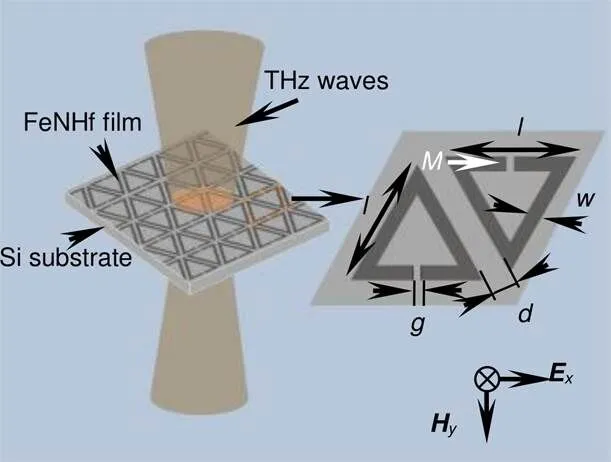
1 引 言
超材料具有天然材料所不具备的电磁响应特性,基于超材料可以研制太赫兹滤波器、调制器、谐振器等[1-3],从而引起了国际科研工作者的广泛研究[4-5]。目前研究的金属基太赫兹超材料主要由Au金属和低损耗基板材料组成,形成的太赫兹器件难以利用Au金属特性对太赫兹波进行调控[6-7]。如果能够动态调控太赫兹器件中超材料的性能,将进一步拓展器件的实用性。现阶段,调控超材料性能方式主要有通过旋转谐振单元角度或位置改变器件工作频率[8-9],通过改变温度调制超材料性能、对石墨烯结构外加磁场等[10-11],实现对太赫兹波的调控。上述的调制方式很可能会限制调制速度的提高。还有基于GaN或GaAs异质结电调制太赫兹器件[12],该类调制器件在调制深度(>50%)和调制速度(~GHz)上都取得了较好的进展,对太赫兹器件微纳加工提出了较高的要求。然而,采用磁性金属薄膜制备太赫兹超材料的文献报道很少,因此,本文在原有研究太赫兹调制器基础上提出基于FeNHf软磁薄膜的太赫兹微结构,软磁薄膜具有饱和磁化强度高,矫顽场低和各向异性场大等特点,磁化强度方向可在外磁场约8000 A/m下翻转,可调控性较高。同时,与传统的开口环和圆环结构相比,开口三角形结构在相同空间内器件密度大,有利于系统的稳定发挥,在器件中有部分微结构破损的情况下也能发挥器件的大部分功能。实验表明,开口三角形结构中开口部分和边长部分相互耦合形成的亮模和暗模形式同样能激发器件的电磁诱导透明机制,为器件设计提供依据[7]。通过外磁场调控太赫兹微结构中软磁薄膜磁化强度与太赫兹磁场的方向,对透射的太赫兹波产生不同程度的微扰,实现对太赫兹微结构工作频率或太赫兹波透射率的调控。该磁性薄膜太赫兹微结构无需在结构上制备电极等调制单元,以非接触方式对太赫兹波进行调控,为太赫兹无源器件的研究提供一种新的途径。
2 实 验
磁性薄膜太赫兹微结构是基于半导体微纳加工技术制备得到,选用电阻率为8000 Ω∙cm的双面抛光高阻硅为基片,裂片后尺寸为10 mm×10 mm×0.5 mm。首先对硅基片进行清洗,接着涂覆RZJ-306光刻胶,曝光显影后对应的太赫兹微结构光刻胶部分被去除。采用高真空磁控溅射设备沉积厚度约为50 nm的FeNHf薄膜,采用Bruker台阶仪测量薄膜的厚度。靶材为纯度99.99% Fe靶,金属Hf片放置在靶上,面积约为Fe靶的1%。射频功率80 W,沉积气体为Ar和N2,沉积气压为0.5 Pa。将沉积FeNHf薄膜样品浸泡在丙酮溶液中进行剥离工艺,剥离后微结构显微照片如图1(a)。太赫兹传输特性采用THz Photonics TP15K太赫兹时域光谱(terahertz time domain spectroscopy,THz-TDS)系统,样品的磁性能由综合物性测量系统(PPMS)表征。FeNHf薄膜磁导率采用基于微扰法的谐振腔测试得到。器件的工作频率由微结构的尺寸和介质材料共同决定,如图1(b),样品微结构参数=100 µm,=5 µm,=8 µm,=5 µm,开口位于三角形边长中心处。
3 结果与讨论
图2是沉积10 min的FeNHf薄膜的轮廓图。FeNHf薄膜厚度约为50 nm,插图为FeNHf薄膜的原子力表面形貌图,扫描范围为500 nm×500 nm,薄膜的平均颗粒尺寸约为6.7 nm。同时,通过范德堡法测试得到FeNHf薄膜(5 mm×10 mm)的面电阻率约为2×10-6Ω∙m。
图3(a)为FeNHf薄膜样品的磁滞回线,可以看到薄膜具有显著的软磁特性和磁各向异性。FeNHf薄膜易轴方向矫顽场为3.5 Oe,难轴方向矫顽场为10.4 Oe,饱和磁化强度4π为15.1 kG,在8000 A/m外磁场下可实现绝大部分的磁化强度翻转。图3(b)为采用基于微扰法测试FeNHf薄膜磁导率随频率的曲线。图中可以看到复数磁导率='-i''的实部'和虚部''与频率的关系,在0.3 GHz下,薄膜难轴方向的磁导率约为408,共振频率为2.02 GHz,易轴方向无法测试到铁磁共振信号,说明可以通过外磁场调控磁导率在难轴和易轴的方向。根据Landau-Lifshitz-Gilbert对磁化进动的理论阐述,对于具有面内单轴各向异性的软磁薄膜,铁磁共振频率可以近似表达为[13]
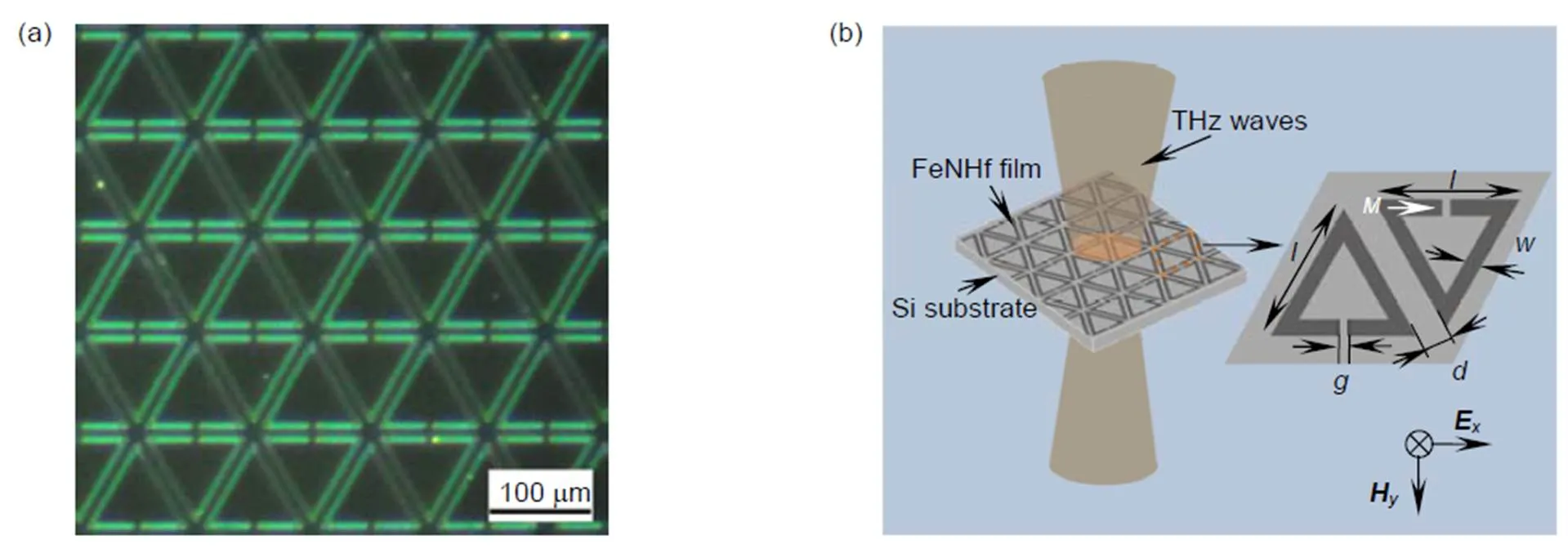
图1 (a) 超材料结构的实验照片;(b) TDS测试和非对称三角形结构尺寸示意图
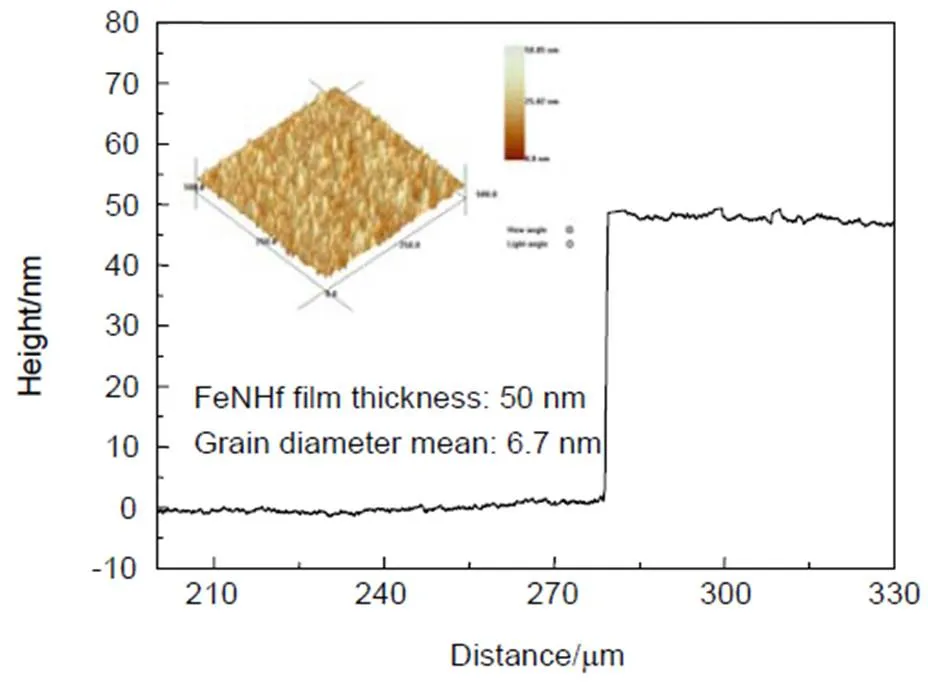
图2 FeNHf薄膜轮廓图和表面形貌图

图3 FeNHf 薄膜。(a) 磁滞回线;(b) 复数磁导率与频率曲线

式中:、k和分别表示旋磁比、各向异性场和饱和磁化强度,通过PPMS测量,FeNHf薄膜样品的k为38 Oe,通过计算可以得到2π约为2.67 MHz/Oe。


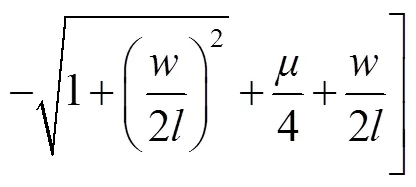
其中:和分别为金属线的长度和宽度,为有效的磁导率。因此,由磁化强度变化引起的磁导率变化导致了有效电感值的变化,最终使得太赫兹微结构谐振频率发生变化。实验和模拟结果统计在表1中,调控磁化强度方向,谐振频率峰位移动了∆r2 GHz,谐振频率峰位移动了∆r9 GHz,电磁诱导透射峰峰位移动了∆r45 GHz,谐振频率峰位移动了∆r63 GHz,四个谐振频率调谐率约为1.1%~5.7%。不同谐振峰来自于不同谐振模式,峰位谐振来源于三角形边的电磁耦合[7],磁化方向变化对边长有效磁导率的改变较为明显,因此在四个峰位中由边长引起的谐振峰位∆r变化最为明显。由此,外磁场调控铁磁薄膜的磁化强度方向能有效调控太赫兹微结构的谐振频率。
同时,图4(a)中给出了Au薄膜制备相同尺寸的太赫兹微结构透射曲线,磁性金属薄膜与Au金属薄膜制备的太赫兹微结构虽然表现出一致的电磁谐振行为,但磁性太赫兹微结构具有其显著的特点,一是磁性微结构谐振频率比Au薄膜微结构谐振频率低,这主要是因为磁性微结构具有较高的等效电感值。二是磁性微结构透射深度比Au薄膜微结构的低,这主要是磁性薄膜电阻率高于Au薄膜所引起的太赫兹欧姆损耗较大而导致。图4(b)为基于时域有限差分方法(FDTD)模拟不同磁化方向的铁磁薄膜基太赫兹滤波结构的透射谱,模拟时磁导率设置为各向异性值=(20,1,1)。可以看出,当磁化强度平行于太赫兹波磁场时,微结构谐振频率低于磁化强度垂直于太赫兹波磁场时的谐振频率,模拟结果与实验测试是一致的。同时,微结构调制深度在实验测试与模拟之间数值上有一定的差异,其中调制深度差异约65%,谐振频率存在约10%的差异。分析认为,有以下两个因素导致了实验和模拟之间的差异。第一,经过光刻工艺后,图形化FeNHf薄膜的电阻率很可能远高于2×10-6Ω∙m,这会导致微结构中电子浓度的降低,从而减小了微结构的调制深度。第二,实验中制备的超材料结构的完整性与模拟结构有一定的差距,这会导致微结构谐振频率的偏移。
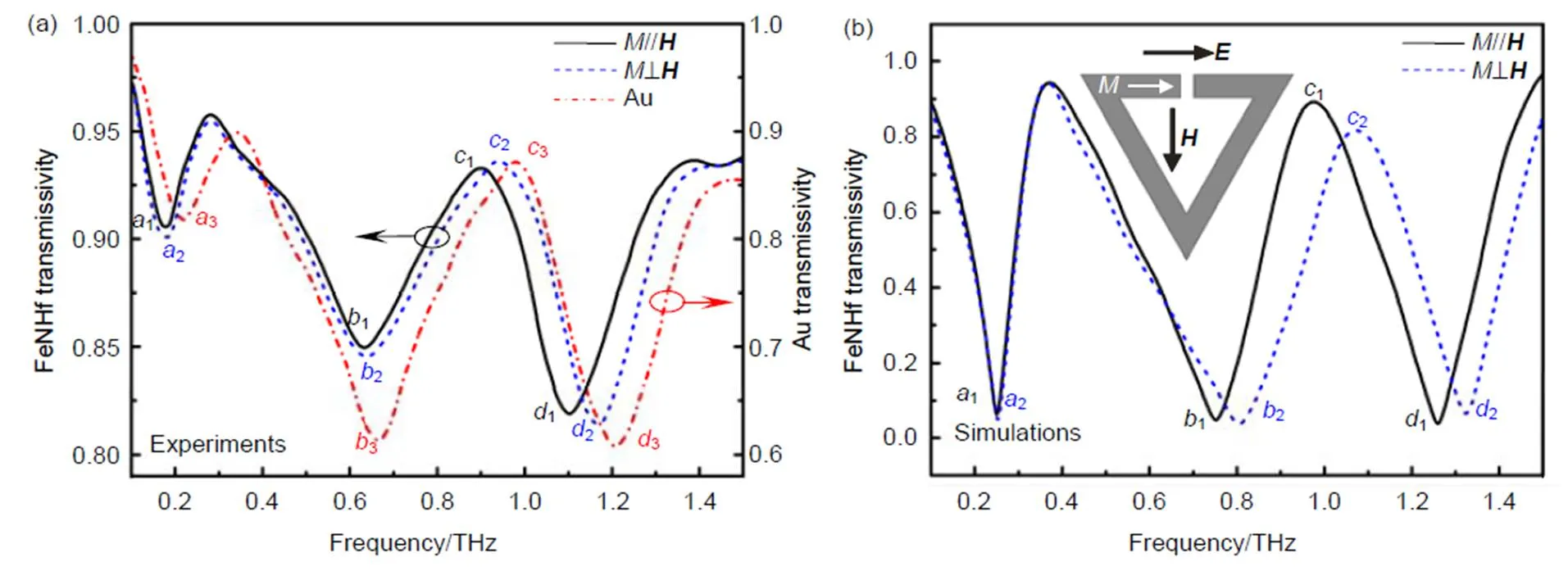
图4 样品的THz透射率。(a) FeNHf薄膜和Au薄膜结构的实验结果;(b) FeNHf薄膜结构的模拟结果
为了更好地理解磁化强度方向分别平行和垂直THz波磁场时对FeNHf磁性微结构在谐振模式下的影响,图5给出了峰位在分别平行和垂直时的磁性薄膜微结构太赫兹电场强度和磁场强度的分布图,电磁谐振峰位主要来源于三角形边长的电磁耦合。图5(a)和5(b)为微结构的太赫兹电场强度分布,可以看到,磁化方向的变化对太赫兹电场强度的改变不足1%。图5(c)和5(d)为微结构的太赫兹磁场强度分布,方向的变化引起的太赫兹磁场强度变化约为14%。所以,磁化强度对峰位频率的改变主要是太赫兹磁场强度的变化,磁性薄膜磁化强度通过对太赫兹磁场的影响可以实现对太赫兹波调控。

表1 太赫兹微结构各谐振峰数据
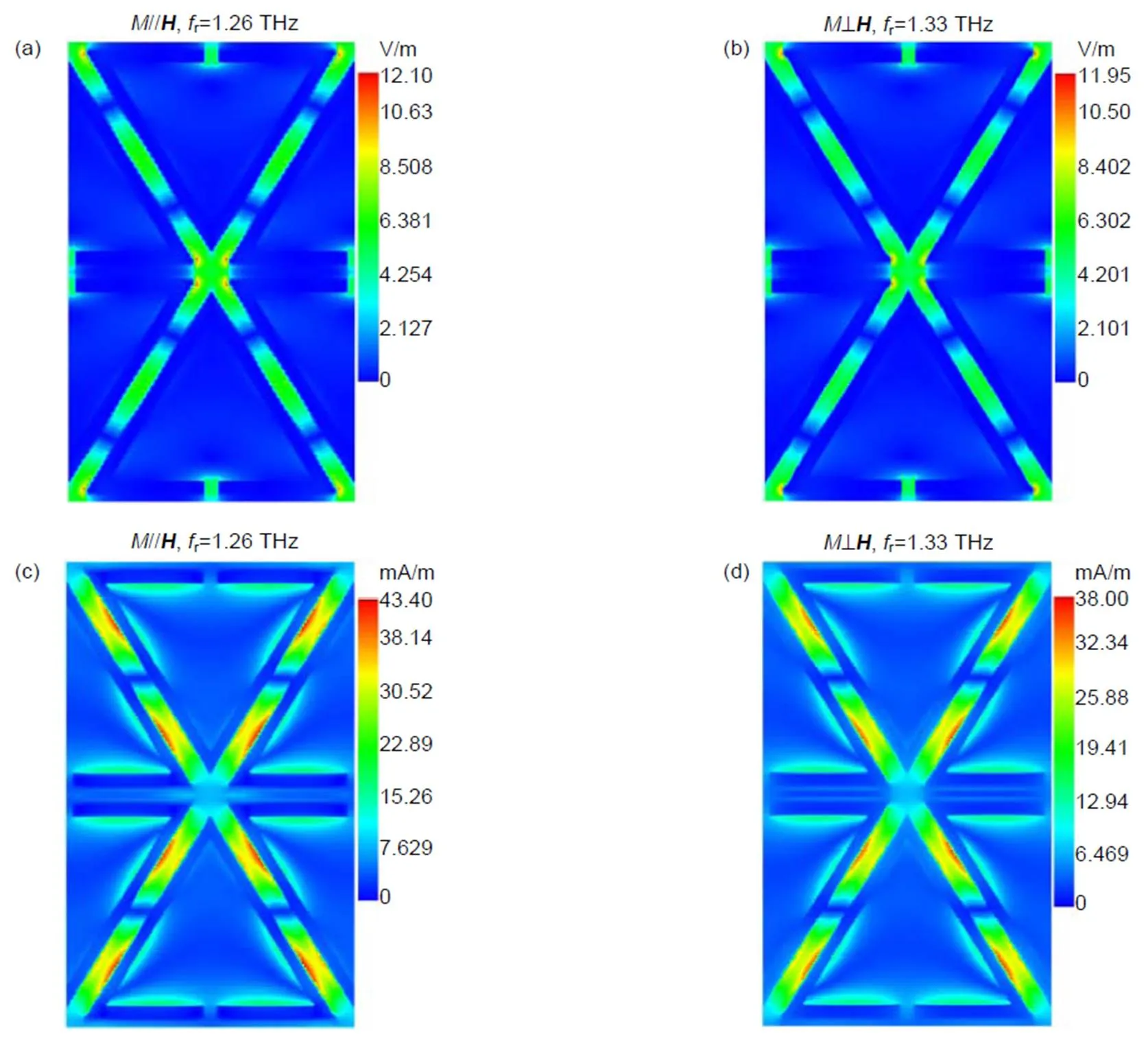
图5 d峰位在磁化强度M分别平行和垂直H时,磁性薄膜结构在(a) fr=1.26 THz,(b) fr=1.33 THz的电场分布;(c) fr=1.26 THz,(d) fr=1.33 THz的磁场分布
4 结 论
本文在基于半导体微纳工艺技术上制备FeNHf软磁薄膜太赫兹微结构,软磁薄膜具有良好的磁各向异性,外磁场约8000 A/m可较好调控微结构中磁化强度的方向。通过外磁场调控微结构磁化强度方向能有效调控太赫兹微结构谐振频率,在1.3 THz频段最大调谐率约5.7%。基于时域有限差分法的模拟结果较好地与实验测试结果一致。利用磁性薄膜磁化强度对太赫兹波的调控为探索太赫兹波器件提供了新的途径。
致 谢
本文工作得到了南京大学金飚兵教授和张彩虹老师在THz-TDS测量上的帮助,苏州大学汤如俊老师在PPMS磁性能测试上的帮助,以及苏州科技大学姜昱丞老师在光刻工艺上的指导,在此一并表示感谢。
[1] Shen N H, Massaouti M, Gokkavas M,. Optically implemented broadband blueshift switch in the terahertz regime[J]., 2011, 106(3): 037403.
[2] Zhang X Y, Xing Y Y, Zhang Q,. High speed terahertz modulator based on the single channel AlGaN/GaN high electron mobility transistor[J]., 2018, 146: 9–12.
[3] Schurig D, Mock J J, Justice B J,. Metamaterial electromagnetic cloak at microwave frequencies[J]., 2006, 314(5801): 977–980.
[4] Pendry J B. Negative refraction makes a perfect lens[J]., 2000, 85(18): 3966–3969.
[5] Smith D R, Pendry J B, Wiltshire M C K. Metamaterials and negative refractive index[J]., 2004, 305(5685): 788–792.
[6] Gu Y P, Xing Y Y, Zhang X Y,. Enhancement of the electromagnetic energy in the asymmetric split rings with compensated microstructures[J]., 2018, 50(4): 168.
[7] Xing Y Y, Zhang X Y, Zhang Q,. Electromagnetic resonance in the asymmetric terahertz metamaterials with triangle microstructure[J]., 2018, 415: 115–120.
[8] Tang Y Z, Ma W Y, Wei Y H,. A tunable terahertz metamaterial and its sensing performance[J]., 2017, 44(4): 453–457.
唐雨竹, 马文英, 魏耀华, 等. 一种旋转可调的太赫兹超材料及其传感特性[J]. 光电工程, 2017, 44(4): 453–457.
[9] Ma C W, Ma W Y, Tan Y,. High-factor terahertz metamaterial based on analog of electromagnetically induced transparency and its sensing characteristics[J]., 2018, 45(11): 180298.
马长伟, 马文英, 谭毅, 等. 高值THz类EIT超材料及传感特性研究[J]. 光电工程, 2018, 45(11): 180298.
[10] Chen H T, Yang H, Singh R,. Tuning the resonance in high-temperature superconducting terahertz metamaterials[J]., 2010, 105(24): 247402.
[11] Liu C, Cao M, Xu G D,. Research on the property of electromagnetic wave in nanostructure based on magnetic modulation[J]., 2016, 33(2): 19–22.
刘畅, 曹明, 徐国定, 等. 基于磁调控微纳复合结构的电磁波特性研究[J]. 苏州科技学院学报(自然科学版), 2016, 33(2): 19–22.
[12] Zhang Y X, Qiao S, Liang S X,. Gbps terahertz external modulator based on a composite metamaterial with a double-channel heterostructure[J]., 2015, 15(5): 3501–3506.
[13] Russat J, Suran G, Ouahmane H,. Frequency-dependent complex permeability in rare earth-substituted cobalt/nonmagnetic transition metal soft ferromagnetic amorphous thin films[J]., 1993, 73(3): 1386–1389.
[14] Grover F W.[M]. New York: Dover Publications, 2004.
Tunable terahertz structure based on the ferromagnetic film
Zhang Qiang, Zhang Xiaoyu*, Xing Yuanyuan, Zhao Lei
Jiangsu Key Laboratory of Micro and Nano Heat Fluid Flow Technology and Energy Application, School of Mathematics and Physics, Suzhou University of Science and Technology, Suzhou, Jiangsu 215009, China
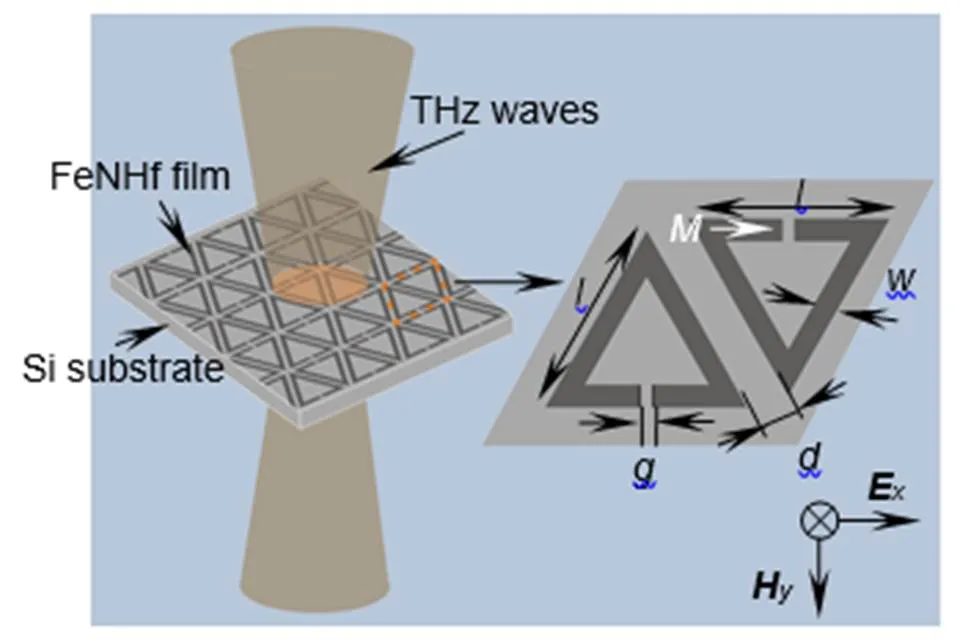
Schematic of THz TDS measurement and geometry of the asymmetric triangular structures
Overview:The terahertz (THz) microstructure is generally fabricated by Au film. It is difficult to control the THz wave by using the physical properties of Au film when the dimension of Au structures are fixed. It is suggested that combination of the tunable materials with the microstructure can improve the performance of terahertz microstructure and simplify the fabrication process. In this paper, the THz microstructure based on the magnetic FeNHf film is fabricated by using the high vacuum RF magnetron sputtering on the high resistivity silicon substrate. A complete terahertz microstructure of FeNHf magnetic thin film was prepared by the semiconductor micro-nano processing technology. The transmission characteristics of magnetic microstructure were characterized by the terahertz time-domain spectroscopy (THz-TDS). The THz transmission of magnetic microstructures were measured under the different external magnetic field. The soft magnetic FeNHf film has the high magnetization of ~16000 kG and the low coercivity of 3 Oe. The magnetic field~ 50 Oe can change the direction of the magnetizationin FeNHf film perpendicular and parallel to the terahertz magnetic field, respectively. The THz transmission and electromagnetic resonance of the magnetic THz microstructure are systematically studied with the change of the external field. The distribution of terahertz electromagnetic field and the surface current distribution based on the FeNHf film microstructure are discussed by the finite difference time domain method. The mechanism of the modulation of THz transmittance and resonance frequency of the magnetic microstructures is clarified with the change of the magnetic field. At the same time, for the comparison, the THz transmission characteristics of the microstructures with the same dimensional Au film are also discussed. The experimental results show that the resonance frequency of the split triangular THz microstructure can be modulated under magnetic field. At the frequency of 1.3 THz, the tunability and modulation depth are about 5.7% and 15%, respectively. The change of magnetization of FeNHf film which results in the perturbation of the magnetic field of terahertz wave. Furthermore, the distribution of electrons in FeNHf film will be changed under the external field, and the effective inductor is varied in the terahertz region. Therefore, it is found that the resonance frequency of FeNHf microstructure shifts to the lower frequency when the magnetization is perpendicular to the magnetic field of terahertz. Experimental and theoretical research on the THz transmission of the magnetic microstructure can further improve the understanding of the THz modulation mechanism for the active devices. At the same time, our efforts provide more experimental data for the development of passive THz devices.
Citation: Zhang Q, Zhang X Y, Xing Y Y,Tunable terahertz structure based on the ferromagnetic film[J]., 2020, 47(6): 190447
Tunable terahertz structure based on the ferromagnetic film
Zhang Qiang, Zhang Xiaoyu*, Xing Yuanyuan, Zhao Lei
Jiangsu Key Laboratory of Micro and Nano Heat Fluid Flow Technology and Energy Application, School of Mathematics and Physics, Suzhou University of Science and Technology, Suzhou, Jiangsu 215009, China
Au film is mainly used to prepare the metal structure of the terahertz (THz) microstructure. When the metal structure is fixed, it is difficult to control the terahertz wave by using the properties of Au film. In this paper, the terahertz microstructure based on the soft magnetic FeNHf film with the high permeability is designed and fabricated on the high resistivity silicon substrate. The magnetization direction of soft magnetic film is controlled by the external magnetic field. The THz transmission characteristics and electromagnetic resonance mode of the microstructure under the control ofin split triangular structure are systematically studied. The soft magnetic FeNHf film has the characteristic of magnetic anisotropy. Therefore, the direction of the magnetizationin FeNHf film can be controlled by the external magnetic fieldto be perpendicular and parallel to the magnetic field of THz wave, respectively. The THz time domain spectroscopy system is used to test the terahertz transmission characteristic of the microstructure. The finite difference time domain method is used to analyze the THz electromagnetic field distribution and modulation mechanism based on the microstructure of the FeNHf film. The experimental results show that the resonance frequency of the split triangular THz microstructure can be modulated under magnetic field. At the frequency of 1.3 THz, the tunability and modulation depth are about 5.7% and 15%, respectively.
terahertz waves; soft magnetic film; magnetic permeability; magnetic anisotropy
TB872
A
10.12086/oee.2020.190447
章强,张晓渝,邢园园,等. 基于铁磁薄膜可调谐太赫兹微结构的研究[J]. 光电工程,2020,47(6): 190447
: Zhang Q, Zhang X Y, Xing Y Y,. Tunable terahertz structure based on the ferromagnetic film[J]., 2020,47(6): 190447
Supported by National Natural Science Foundation of China (61107093), Suzhou Key Laboratory for Low Dimensional Optoelectronic Materials and Devices (SZS201611), Jiangsu Key Disciplines of Thirteen Five-Year Plan (20168765), Natural Science Foundation of the Jiangsu Higher Education Institutions of China (19KJA140001), and the Graduate Research and Practice Innovation Project of USTS (SKCX18_Y13).
* E-mail: xyzhang@usts.edu.cn
2019-07-28;
2019-11-04
国家自然科学基金资助项目(61107093);苏州市低维光电材料与器件重点实验室(SZS201611);江苏省十三五重点学科项目(20168765);江苏省高等学校自然科学研究项目(19KJA140001);苏州科技大学研究生科研创新计划项目(SKCX18_Y13)
章强(1994-),男,硕士研究生,主要从事微纳结构远红外滤波器的调控研究。E-mail: 1224052592@qq.com
张晓渝(1978-),男,博士,副教授,主要从事基于半导体材料和铁性薄膜材料微波-远红外光电器件的调控机理研究和器件研制。E-mail:xyzhang@usts.edu.cn

